Coin Values Moving with Precious Metals: Up-Dated 12/8/2025: Gold $4212 | Silver $58.12
Grading Mercury Dimes | How to Video
Once a Mercury dime enters circulation and begins to wear, distinct patterns to this wear develop. Major and minor elements of the design fade and eventually merge. These different stages of wear are judged and used to assign a grade. Video | Descriptions | Images identify the indicators to grading Mercury dimes.
First impressions of your coin is an indication of its overall grade. A faded "worn" look signals a dime in the good grade. A coin with visual contours within the face and hair of Liberty suggest the Fine grade. If your dime displays distinctly sharp details overall, especially on the reverse of the coin, it becomes a candidate for the Extremely Fine grade.
Uncirculated Condition
Tops on the wants lists of collectors are Mercury dimes in Uncirculated - Mint State grade. These coins retain all original design elements; none of the details show any signs of wear.
Important to recognizing this grade... is judging Mint Luster is present and covers the entire surface. When first minted a luster is imparted to the surface during the striking process. This gives the brilliant shine to the coin, however luster is a delicate texture and susceptible to wear.
The above video demonstrates the vibrancy of luster to the surface. Rotating the coin under a light causes the shine to travel over the coin covering both the highest and lowest part of the surface.
Highest areas of the design are judged first with the intent of detecting any wear.
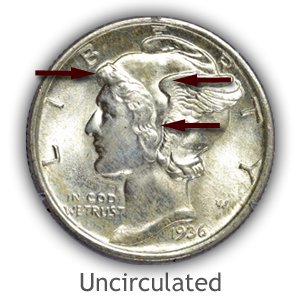
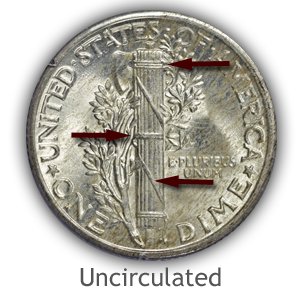
Obverse:
- The wave of hair above Liberty's eye is highest in profile on the obverse. Prone to first signs of wear, confirm no signs of dulling and smoothness is evident.
- Curls and waves of hair to right of the eye and above the ear must retain the texture of luster.
- The leading edge of the wing is also inspected. Finding no areas of flatness indicates the mint state grade.
- Lower portion of the wing is judged for smoothing and dulling.
- Liberty's cheek presents a wide open area prone to dulling with any wear. Under a light, slowly tilt the coin and judge the completeness of luster over the entire surface.
Reverse:
- The center horizontal bands are key to the uncirculated grade. Located in the very middle of the coin and high in profile these bands received wear quickly. Judge the presence of mint luster and no smoothing.
- Upper horizontal bands are also inspected. These would also lose their profile and luster if worn.
- Both diagonal bands crossing the bundle remain free from wear on mint state graded coins. Inspect the middle areas of both for any dullness to the surface.
- Further judge the condition of the olive branch. All elements of the branches and leaves have a rounded profile, mint lusted must remain overall.
Extremely Fine Condition
In the Extremely Fine grade a Mercury dime shows evidence of slight wear to the highest points of the design. Mint luster is absent from the majority of the coin often with small areas of luster showing within the lettering and close to the rim. Certain key elements must remain to reach this grade.
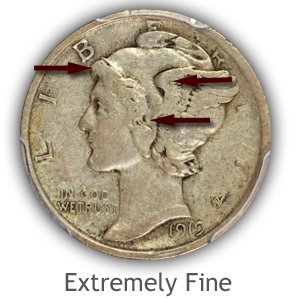
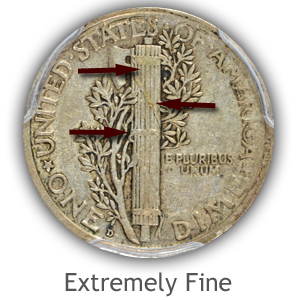
Obverse:
- With only minor flattening... the hair above the eye remains mostly rounded. A contour is visible within the hairline at the forehead.
- Waves of hair to the right of the eye show minor flat areas however the waves are separated by major lines. Hairline separating the forehead is visible.
- Looking closely at the wing... flatness shows along the forward edge. Just the slightest amount of merging with the cap is evident.
- Light smoothing is confined to the ends of the feathers. One or two lines separating the large feathers are faded and about to merge.
- Liberty's cheek and jaw retain their contour and profile. Smoothing is evident but no wide areas of flatness are showing.
Reverse:
- Central horizontal bands are now worn and flattened in the center. Little if any of the line separating the two bands is visible. However the band is clearly raised from the vertical lines.
- Diagonal lines remain mostly complete and raised. Slight merging with the vertical lines is often found but the merging is limited to the very center.
- Vertical lines are virtually complete. Often the 2nd and 3rd lines from the right are quite faded together especially just above the bottom diagonal line.
- All leaves of the olive branch are well defined, including those touching the vertical lines.
Fine Condition
In the Fine grade this dime is clearly worn, both on the obverse and reverse, however not overly so. Major design elements remain strong and ample finer details are visible. The subtle factor separating this Mercury dime from a higher grade is the flatness of once rounded contours.
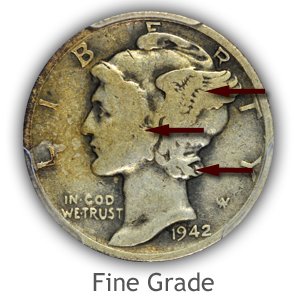
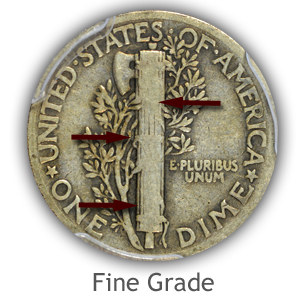
Obverse:
- Hair details to the right of the eye are now merged with the forehead and cheek.
- Separation of the hair from the cap remains, however the hair itself is flat with little detail remaining.
- Within the wing, all three "rows" of feathers are separated with detail.
- Liberty's cheek and the area of the jaw line are worn flat. The once rounded cheek and jaw contours are now leveled and one flat plane remains.
- Hair curl at the back of the head near the neck line retains a slight amount of roundness to its profile. Keeping this coin in the fine grade is the presence of a subtle "valley" in the contour between the hair curl at the back of neck and the closest edge of the wing just above.
Reverse:
- Central horizontal bands have worn extensively and faded into the vertical lines. Just trace evidence of separation from the lines remains.
- Diagonal bands are weak in definition especially across the centers.
- Vertical lines remain mostly along the outer edges and only partial lines are found in a few places of the bundle.
Good Condition
Wear gives a Mercury dime in the good grade the appearance of flatness to the coin covering the entire surface. Liberty does remain well outlined, giving a bold appearance to the center of the coin. Condition of the rim is the defining element to judge in deciding the grade.
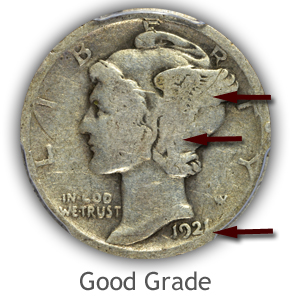
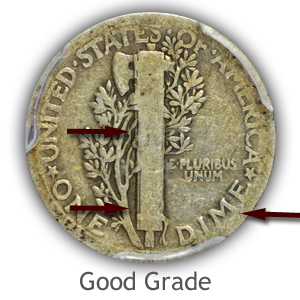
Obverse:
- Rim is now worn to the point of touching the tops of the lettering and often the last digit of the date.
- Feather detail within the wing is all but missing. Evidence of the original separation of the rows of feathers within the wing may show just slightly.
- Lower half of wing has worn smooth and merged with the cap.
- Hair detail at the back of neck is now well connected with wing and cap.
Reverse:
- Central detail of the fasces has worn to a flat outline.
- All horizontal lines defining the top, center, and bottom bands have completely worn into the vertical lines.
- Vertical lines are now gone with just faint traces of partial lines along the outer edges.
- Rim has worn to the point of merging with the tops of the lettering.
- When grading Mercury dimes often the condition and state of wear to the reverse becomes the deciding factor to recognizing a coin in the Good grade from one higher.
Accurate Grading Mercury Dimes = Value
Any Mercury dime dated before 1934 is worth grading with a critical eye. Within the years 1916 to 1931 are many dates and mint marked coins worth well above the current 12/8/2025 value of $4.26 .
Grading Mercury dime involves not only the technical side, judging the amount of wear to the surface. Also considered is overall eye appeal of the coin, does it project a pleasing appearance or a dull "worn out" look. Wear to the surface does not immediately disqualify the coin from collector status. Pleasing character is found in any grade.
Tied closely with visual appeal are coins within a grade displaying strong features and special characteristics for the grade.
Full Bands Adding Premium Value
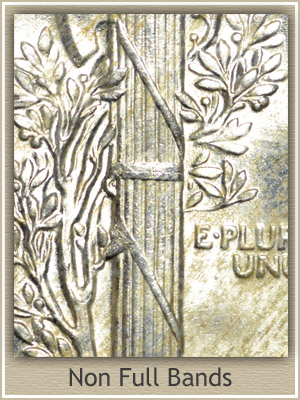
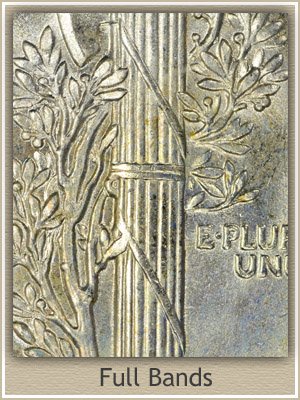
Well established in the collecting community are premium values awarded to mint state Mercury dimes displaying fully struck central horizontal bands. When judged full bands, the notation "FB" is added to the grading description of the coin.
A significant number of Mercury dimes left the mint softly struck. The reverse of the coin displays this softness in the area of the central horizontal bands. A fully struck coin displays two separated bands, each rounded in profile.
It's within the mint state grade this added metric is applied. Circulated - worn coins naturally loose this separation, it is only uncirculated coins receiving the "FB" (full band) notation.
Inspect the bands closely, an unbroken line with complete separation across the entire band is needed.
Vertical Lines Adding Market Acceptance
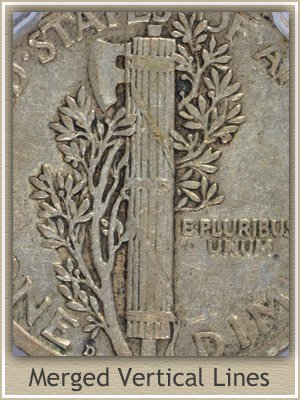
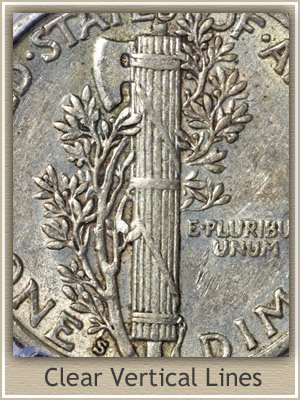
An Extremely Fine grade Mercury dime has a special quality found in the vertical lines. Slight merging of the second to third vertical line is accepted and still allows the coin to grade Extremely Fine.
Detecting all vertical lines well defined gives the coin a more complete look and aesthetically appealing. The additional benefit is market acceptance of the grade.
Fading of the vertical lines often occurs in the area just above the diagonal bands. Look closely at both bands, strong defined detail surrounding each is an added appeal to the grade.
Subtle Indication Locks in the Fine Grade
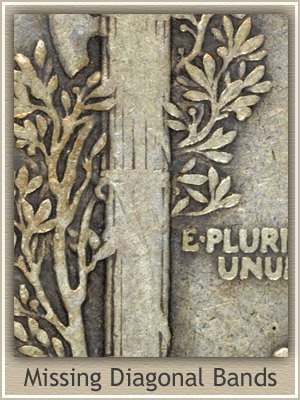
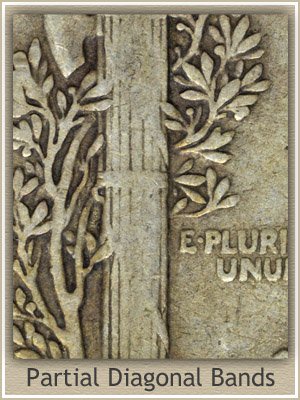
A Fine grade Mercury dime displays wide areas of merging and missing design on the reverse. In the central design, once strongly detailed Horizontal, Vertical and Diagonal lines are faded together. The wearing down of all this detail is what places the coin in the Fine grade.
Expected in the fine grade are missing diagonal lines. Any presence of the diagonal bands, even if faint, improves the appearance of the coin and locks in the grade. It is worth a second look at these moderately worn coins.
Date is Not in Question
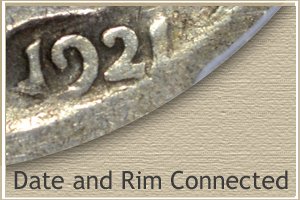
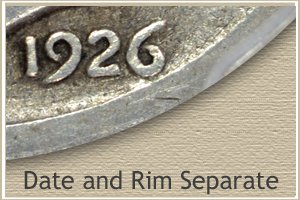
A Mercury dime worn to the point of the Good grade has lost most of the original design. Small detail is missing, many major parts are merged into a flat surface and the rim is fading into the outer parts of the letters.
Finding a special quality to these coins involves the condition of the date and the surrounding area. The date is critical to the value of any coin; it becomes one of the main focal points.
Common to Mercury dimes in Good condition is the last digit of the date partly missing and connected to the rim. Uncertainty of the date is now possible.
The rim connecting with the lettering along the outer edges is what helps define a coin in the Good grade. If the date is spared this condition; separate and bold from the rim it adds character to the coin. A bold date becomes a special quality to recognize. There is no questioning the date and visual appeal is added to a main focal point.
Grading Old Coins || Video Index
Video index of how to grade coins. The different series of coins ranging from Indian Cents to Morgan Dollars are judged with grading descriptions and images. Accurately determining the grade leads to an accurate value.
Mercury Dime Values | Discover Their Worth
Mercury dimes are very popular with collectors today, grading their condition is one of the keys to accurate value. Visit the value chart listing the different dates and mintmarks within the series and the values for each listed by grade.
★Coin Values Discovery pulls together... Grading Mercury Dimes and...
All US coin values. Images of the different coin series link to value charts, listing the dates and mintmarks for each series. Step by step; identify both the condition and grade of your coin | locate important mintmarks and popular varieties.